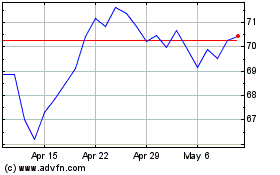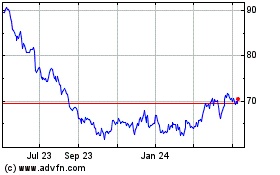'Taste is king' again after turn to healthier versions failed to
break sales decline
By Annie Gasparro
This article is being republished as part of our daily
reproduction of WSJ.com articles that also appeared in the U.S.
print edition of The Wall Street Journal (April 6, 2018).
To get consumers to eat cereal, big food companies are doubling
down on sugary goodness.
Lucky Charms Frosted Flakes from General Mills Inc. and
Chocolate Frosted Flakes from Kellogg Co. are among the industry's
latest answers to the persistent decline in cereal sales.
For years, the big brands tried to go healthy as the main
strategy to win back consumers who had defected to Greek-style
yogurt, protein bars and other breakfast items with more protein
and fewer carbohydrates than cereal. General Mills in 2014 came out
with a higher-protein version of Cheerios and removed any
genetically modified ingredients from original Cheerios. In 2013,
Post Holdings Inc. introduced Honey Bunches of Oats Morning Energy,
which highlighted higher protein and fiber content. And in 2011,
Kellogg started selling a variety of Frosted Flakes with 25% less
sugar and three times the fiber.
That didn't work. Overall cereal sales in the U.S. have declined
11% over the past five years to around $9 billion in 2017,
according to Mintel, a consumer research firm. Post CEO Robert
Vitale said cereal has lost a tenth of its shelf space as a
result.
Now, many food manufacturers are going back to basics. Consumers
of cereal -- children and adults alike -- care less about nutrition
and more about fun flavors, range of colors, and sweet taste,
according to market research firms and food company executives. And
many aren't necessarily eating it for breakfast, and instead are
treating it as a snack or even dessert, they said.
"Taste is king," said Dana McNabb, General Mills' president of
cereal. Ms. McNabb, who oversaw the company's latest creations --
Chocolate Peanut Butter Cheerios, Lucky Charms Frosted Flakes and
Cinnamon Toast Crunch shredded wheat -- said those new products are
selling better than the company's healthier twists on their
so-called fun brands. "What we realized is that trying to do the
same thing across all of our cereals doesn't work."
General Mills revived its discontinued artificially
colored-and-flavored Trix cereal last year after consumers
complained about the dull look and different taste of the
all-natural ingredients the company had used as substitutes. "Trix
is the best example of what happens when you do something the
consumer doesn't like: They let us know," Ms. McNabb said.
Sales of children's cereal, which includes many indulgent
varieties with cartoon mascots, fell about 1% last year. Adult
cereal sales sank 7%, according to market research firm
Nielsen.
Big food makers say they are under no illusion that sales of
cereal -- and other processed foods -- will return to the growth
rates of 1980s. Consumers are moving toward options they think are
fresher and less processed, a trend that seems unlikely to change
anytime soon. Kellogg, General Mills and Post are diversifying
their businesses by buying smaller brands that make other foods, to
protect them from cereal sales determining their fate.
The cereal business, however, is still important, making up a
significant portion of their sales. The companies also stressed
that they aren't abandoning healthier cereals like Special K or
Grape-Nuts.
"Cereal is big, and it is profitable. We recognize that we have
to stabilize it," said Kellogg's new chief executive, Steve
Cahillane. "Frankly, we haven't done enough to keep the consumer
engaged."
Emphasizing taste and getting Americans to eat cereal at times
other than breakfast are the industry's best shot at recovering
from what has been an abysmal decade, said John Owen, a senior food
analyst at Mintel.
"Cereal is processed. It's carbs. It's not so healthy for
breakfast, but it's a permissible indulgence that seems not as bad
as eating a traditional dessert," he said.
Mintel's research shows that 43% of adults eat cereal as a snack
at home, and 30% of cereal consumers say they choose cereal that
tastes good regardless of how nutritious it is.
Dan Goubert, a college student from Grand Rapids, Mich., said he
eats cereal late at night while playing videogames. "I'm not trying
to be healthy. It's a midnight snack kind of thing for me now. It
doesn't fill you up in the morning," he said.
Marissa Kopp, who lives in Naperville, Ill., with her husband
and their two young sons, said that although she is careful to feed
her children unsweetened oatmeal and whole-wheat pasta with added
fiber, she occasionally has cereal for dinner. "I am so much more
into reading food labels for my kids than my husband and I.
Sometimes I'll just have Golden Grahams," she said.
General Mills, the maker of Golden Grahams, in March reported
that retail sales of its cereal rose 2% in the latest quarter,
thanks to Peanut Butter Chocolate Cheerios and Lucky Charms Frosted
Flakes.
Post recently brought back Oreo Os cereal, its offering made to
taste like the popular Nabisco cookies that it had discontinued in
2007. And it stopped selling its newer Morning Energy variety of
Honey Bunches of Oats. Kellogg discontinued its lower-sugar Frosted
Flakes and came out with chocolate and cinnamon varieties.
After working for years to remove the synthetic dyes in Lucky
Charms' marshmallows, General Mills has abandoned that goal and
instead recently came out with a new unicorn-shaped marshmallow to
boost sales. The unicorn has gotten a lot more attention from
consumers than Ancient Grain Cheerios ever did, Ms. McNabb said.
"Unicorns are popular. But unicorns and Lucky Charms are
magical."
Write to Annie Gasparro at annie.gasparro@wsj.com
(END) Dow Jones Newswires
April 06, 2018 02:47 ET (06:47 GMT)
Copyright (c) 2018 Dow Jones & Company, Inc.
General Mills (NYSE:GIS)
Historical Stock Chart
From Mar 2024 to Apr 2024

General Mills (NYSE:GIS)
Historical Stock Chart
From Apr 2023 to Apr 2024
